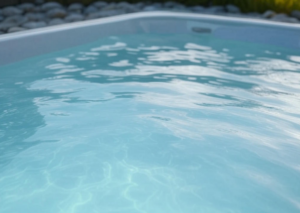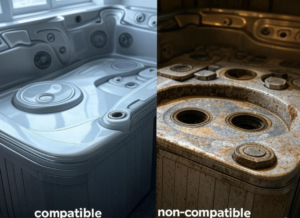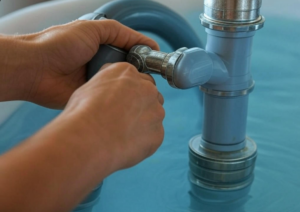Can Any Hot Tub Be a Saltwater Tub?
An Expert Guide to Conversion and Compatibility
Discover the truth behind converting your hot tub to a saltwater system. This guide explains the basics, digs into the details, and shows you how to decide if your hot tub is a good match for a saltwater setup.
Introduction
Saltwater hot tubs are growing in popularity. Many people love how the water feels softer and gentler on the skin. They also enjoy the lower chemical odor and easier maintenance. But can any hot tub be turned into a saltwater tub? The answer is: it depends.
A saltwater system uses a salt-chlorine generator to turn salt into chlorine. This process uses simple science called electrolysis. In plain words, salt is added to the water, and a low-voltage current turns it into a steady supply of chlorine. This makes the water safe and clean while reducing the need to add harsh chemicals.
In this guide, you will learn:
- How saltwater systems work: We break down the science in simple terms.
- Compatibility issues: Not all hot tubs are built the same. We discuss which materials work best.
- The conversion process: Step-by-step instructions help you plan a conversion.
- Maintenance and troubleshooting: Learn how to keep your saltwater system running smoothly.
- Long-term considerations and expert advice: We cover the costs and care needed for lasting performance.
This post is written for anyone who wants clear, reliable information. It uses short sentences and familiar words. You will get a mix of technical details and practical advice that is easy to understand. Let’s begin our deep dive into whether your hot tub can be a saltwater tub.

Main Topic Exploration
Understanding Saltwater Hot Tub Systems
Saltwater hot tubs work by using a salt-chlorine generator. Here’s how it works:
- Salt Addition: You add a specific amount of salt to the water. The common range is 2,000–3,000 parts per million (ppm).
- Electrolysis: The generator sends a low-voltage current through the water. This breaks down the salt into sodium and chlorine.
- Sanitization: The chlorine produced cleans the water. It kills bacteria and keeps the water safe for use.
Many users find the water feels smoother and is easier on the eyes. Still, remember that saltwater hot tubs are not chlorine-free. They simply produce chlorine in a controlled way.
Compatibility Factors
Not every hot tub is built to handle saltwater. Key points include:
-
Materials and Design:
Hot tubs use different materials for parts like heaters, pumps, and plumbing. Salt can be more corrosive than fresh water.- Good Materials: Titanium, high-grade stainless steel, and salt-resistant plastics.
- Risky Materials: Copper, low-grade metals, or parts not designed to resist salt.
-
Manufacturer Guidelines:
Some hot tubs are made with saltwater in mind. Check your manual or ask the manufacturer. Changing the water chemistry might void your warranty if your tub is not designed for salt. -
Installation Needs:
Adding a salt-chlorine generator often requires careful installation. The generator must fit well with the tub’s plumbing and electrical system.

Conversion Process
If you decide to convert your hot tub, here are the key steps:
-
Assess Your Tub:
- Check the materials.
- Read the manual and consult the manufacturer.
-
Drain and Clean:
- Empty your hot tub.
- Clean it thoroughly to remove old chemicals.
-
Install the Saltwater Generator:
- Choose between drop-in or in-line systems.
- Follow the installation instructions carefully.
-
Add Salt and Balance Water:
- Add the correct amount of salt (about 2,000–3,000 ppm).
- Adjust pH, alkalinity, and calcium hardness as needed.
-
Regular Maintenance:
- Clean the salt cell every 60–90 days.
- Check water chemistry weekly.
Here is a tool to help you with the conversation process
Custom Tables for Quick Reference
Table 1: Traditional vs. Saltwater Hot Tub Comparison
Table 2: Material Compatibility
| Component | Compatible Material | Non-Compatible Material | Recommendation |
|---|---|---|---|
| Heater | Titanium, 316L stainless steel | Copper | Upgrade if necessary |
| Pump and Jets | Plastic, marine-grade stainless steel | Low-grade metals | Inspect for corrosion risk |
| Plumbing | PVC, CPVC | Exposed metal fittings | Ensure sealed connections |
| Fittings | Salt-resistant plastics | Brass, non-coated metals | Replace if needed |
Visual Diagram of Saltwater Conversion Process
Below is a simple HTML diagram that shows the flow of the saltwater conversion process:
Comparative Analysis
To decide if your hot tub can become a saltwater tub, compare the options. Here are some key points:
-
Cost vs. Benefit:
- Traditional systems have lower upfront costs but require regular chlorine additions.
- Saltwater systems may cost more initially but lower ongoing chemical expenses.
-
Ease of Maintenance:
- Traditional hot tubs need frequent chemical handling.
- Saltwater systems automate chlorine generation, though they need regular cell cleaning.
-
Material Compatibility:
- Newer hot tubs made of corrosion-resistant materials are more likely to support saltwater.
- Older models or those with exposed metals may need upgrades.
-
User Experience:
- Saltwater tubs offer a gentler water feel.
- However, if your hot tub is not designed for salt, you risk faster wear.
-
Warranty Concerns:
- Converting may void warranties if the manufacturer advises against saltwater use.
- Always check your hot tub manual.
Below is a color-coded summary table for a quick visual reference:
Performance Factors
Understanding the factors that affect saltwater hot tub performance is key. These factors include:
-
Salt Concentration:
The right level (about 2,000–3,000 ppm) is crucial. Too little salt will not generate enough chlorine. Too much may cause scaling and corrosion. -
Water Chemistry:
pH, alkalinity, and calcium hardness must be balanced. Regular testing with strips or digital sensors helps you keep the water safe. -
Component Quality:
Upgraded parts such as titanium heaters and salt-resistant pumps last longer. Poor quality components risk faster wear in saltwater. -
Maintenance Routine:
Cleaning the salt cell and filters on schedule keeps the system efficient. Regular draining and refilling can reduce salt buildup. -
Installation Quality:
A proper installation, often by a professional, helps ensure that all parts work together smoothly.
Visualizing these factors can help. Consider this simple diagram:
Implementation Guide
Follow these steps to convert your hot tub:
-
Gather Information:
- Read your hot tub manual.
- Check manufacturer guidelines regarding saltwater conversion.
-
Assess Compatibility:
- Identify parts made of metals and plastics.
- Determine if your tub uses materials that can handle salt.
-
Drain and Clean the Tub:
- Remove old water.
- Clean the tub to remove chemical residues.
-
Install the Saltwater Chlorine Generator:
- Choose between a drop-in or in-line system.
- Follow the installation instructions closely.
- If unsure, hire a professional.
-
Add Salt and Balance the Water:
- Calculate the salt needed (typically about 2 1/3 cups per 100 gallons).
- Mix the salt until fully dissolved.
- Test water pH and alkalinity, then adjust using pH increasers or reducers.
-
Set Up a Regular Maintenance Schedule:
- Clean the salt cell every 60–90 days.
- Check water chemistry weekly.
- Replace filters as needed.
Expert Tip: Always double-check that each component is saltwater-compatible. Small changes in water chemistry can cause big issues if parts are not suited for salt exposure.
Warning: Avoid using table salt. Use spa-grade salt to prevent impurities that may harm your system.

Troubleshooting
If you face problems, try these steps:
- Low Chlorine Levels:
- Check if the salt level is correct.
- Clean the salt cell to remove scale buildup.
- Corrosion or Rust:
- Inspect metal parts closely.
- Replace any parts that are not saltwater-resistant.
- Imbalanced pH or Alkalinity:
- Use test strips weekly.
- Adjust with pH increaser or reducer.
- Reduced Water Flow:
- Clean jets and filters.
- Check for salt deposits in the plumbing.
Diagnostic Steps:
- Test water chemistry.
- Clean and inspect the salt cell.
- Check all fittings and connections for corrosion.
- Consult a professional if the issue persists.
Regular checks and cleaning help avoid major problems. A steady routine is the best way to keep your saltwater hot tub working well.
Innovation and Extended Applications
Saltwater technology is not new, but new ideas are emerging:
-
Smart Monitoring:
Some systems now offer digital sensors that connect to mobile apps. These apps alert you when water chemistry needs attention. -
Eco-Friendly Designs:
Manufacturers are exploring designs that lower energy use and reduce waste. This is a win for both the user and the environment. -
Hybrid Systems:
New models can switch between traditional and saltwater modes. This gives you more control over maintenance and water feel. -
Advanced Filtration:
Cutting-edge filters now remove more impurities. They work well with saltwater and help extend the life of your tub.
These innovations show that saltwater systems may evolve. In the future, they could offer even more benefits. They may also connect with home automation systems to adjust settings automatically.
Long-term Considerations
When thinking about a saltwater conversion, consider the long run:
-
Sustainability:
Saltwater systems can reduce the need for harsh chemicals. They are also easier on the environment when maintained properly. -
Maintenance Needs:
Regular cleaning and careful monitoring are key. Over time, replacing the salt cell and filters adds to the cost. -
Cost-Benefit Analysis:
While the initial cost is higher, lower chemical expenses and a gentler water feel may be worth it. -
Upgrade Signals:
Watch for signs of corrosion or scaling. If parts show wear, it may be time to upgrade.
A careful balance of cost, maintenance, and performance will help you decide if a saltwater conversion is right for you.
Expert FAQ Section
Q1: Is a saltwater hot tub truly chlorine-free?
A: No. Saltwater systems generate chlorine from salt. The process is different, but chlorine is still present.
Q2: How often should I test my water chemistry?
A: Test your water weekly. Regular checks ensure pH, alkalinity, and salt levels are in the proper range.
Q3: Can I convert any hot tub model?
A: Not all. You must check the materials and manufacturer guidelines to avoid voiding warranties or causing damage.
Q4: What are the main benefits of a saltwater system?
A: The water feels softer, has a lower chemical odor, and you add mainly salt instead of multiple chemicals.
Q5: How much does it cost to convert a hot tub?
A: Conversion kits typically range from $500 to $1,000, plus any additional installation fees and possible upgrades for incompatible parts.
Q6: What maintenance tasks are unique to saltwater systems?
A: Cleaning the salt cell every 60–90 days and regular water chemistry checks are key tasks.
Q7: Are there any risks of corrosion?
A: Yes. If your hot tub has non-compatible materials, salt can speed up corrosion. Always check with your manufacturer first.
Key Takeaways
Remember: Not every hot tub can easily become a saltwater tub.
Tip: Check your hot tub’s materials and manufacturer guidelines before converting.
Remember: Saltwater systems still use chlorine but in a gentler, automated way.
Tip: Regular maintenance is essential to avoid corrosion and scaling.
Conclusion
Saltwater hot tubs offer a softer water feel and lower chemical handling. However, converting a traditional hot tub requires careful planning. You must check materials, follow manufacturer advice, and be ready for regular maintenance. When done right, a saltwater conversion can boost your hot tub experience.
Take the time to assess your current setup. Ask questions, do your research, and consider a professional installation if needed. Your comfort and safety come first. Enjoy a gentler, more enjoyable soak knowing you have the right system in place.
Additional Resources
- Spa and Hot Tub Alliance: Offers guidelines and best practices.
- Consumer Reports on Hot Tubs: Reviews and detailed comparisons.
- Manufacturer Websites: Specific details on models and compatibility.
- Online Forums: Communities where users share real-world experiences.
- Energy Star: Information on eco-friendly hot tub practices.
Technical Glossary
Below is a glossary of key terms to help you understand saltwater hot tubs:
- Electrolysis: The process of using electricity to break down salt into its components.
- Hypochlorous Acid: The chlorine form produced during electrolysis that sanitizes water.
- Parts Per Million (PPM): A unit of measurement for chemical concentration in water.
- pH Balance: A measure of how acidic or basic water is.
- Sanitizer: A substance that kills harmful microbes in water.
- Salt-Chlorine Generator: A device that converts salt into chlorine.
- Scale Buildup: The deposit of minerals on surfaces, often from hard water.
- Alkalinity: The water’s ability to neutralize acid, keeping pH stable.
- Calcium Hardness: The amount of dissolved calcium in water.
- Corrosion: The gradual wearing away of materials, especially metals, due to chemical reactions.
Your next step is to review your hot tub’s manual and consult your manufacturer. Armed with this guide and the recommended tool, you can make a smart decision on whether converting to saltwater is right for you. Enjoy your journey to a cleaner, gentler, and more enjoyable hot tub experience!
Feel free to ask for more details or any clarifications. Your feedback helps us improve our guidance!
